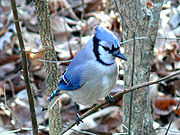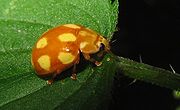
Prey detection
Encyclopedia
Prey detection is the process by which predators are able to detect and locate their prey via sensory
signals. This article treats predation in its broadest sense, i.e. where one organism
eats another.
 Predators are in an evolutionary arms race
Predators are in an evolutionary arms race
with their prey, for which advantageous mutations are constantly preserved by natural selection
. In turn, predators too are subject to such selective pressure, those most successful in locating prey passing on their genes in greater number to the next generation's gene pool
. Adaptations of prey that allow them to avoid protection are widespread, and this general pattern is collectively known as crypsis
. Crypsis may involve temporal evasion such as nocturnality, behavioral methods such as hiding, and non-behavioral adaptations such a camouflage
. Often behavioral and passive characteristics are combined, for example a prey animal may look similar to and behave like its hunter's own predator (see mimicry). In addition, some species (especially bird
s) will actively attack
their predators, preventing them from locating their eggs or young. Predators must overcome this arsenal of cryptic defenses if they are to find a meal and live to see another day.
, olfactory system
(smell), auditory system
(hearing) and the somatosensory system
(such as touch). Some predators may use all of these senses in pinpointing their prey, while others may depend mainly or entirely on a single one. Detection methods may also be divided into direct detection of the prey organism itself, and indirect clues, such as the smell of its urine.
 Visual predators may form what is termed a search image of certain prey.
Visual predators may form what is termed a search image of certain prey.
Predators need not locate their host directly: Kestrel
s for instance are able to detect the feces
and urine
of their prey (which reflect ultraviolet
), allowing them to identify areas where there are large numbers of voles, for example. This adaptation is essential in prey detection, as voles are quick to hide
from such predators.
s can locate their bark beetle
prey using the pheromone
s their targets secrete. Pheromones that are exploited by an enemy like this are called kairomone
s.
cues to detect prey. In nocturnal predators non-visual clues are especially important. The Barn Owl
(Tyto alba) relies on noises made by prey, and has can locate prey animals with great precision. Bat
s have the added capability of echolocation
to locate prey like flying insects; they can therefore locate prey even if they make no sound.
 Once a predator has found its prey it will not always attempt to chase or eat it. Prey have other ways of deterring predators from eating them besides avoiding detection. Aposematic plants and animals may have conspicuous coloration such that potential consumer such as a herbivore
Once a predator has found its prey it will not always attempt to chase or eat it. Prey have other ways of deterring predators from eating them besides avoiding detection. Aposematic plants and animals may have conspicuous coloration such that potential consumer such as a herbivore
will avoid eating them based on unpleasant past experiences. Even if a predator may wish to eat its prey, locomotive animals may be extremely difficult to catch. Animals living in groups have increased vigilance, and even solitary animals are capable of rapid escape when needed. Even if it does make a capture, its prey may attract competing predators, giving it a chance to escape in the struggle. It may also strike a non-vital organ: some species have deceptive appearances such that one part of their body resembles another, such as insects with false heads. This makes consumption (or fatal wound)s less probable, giving the prey a second chance at escaping.
Predators may have extensive capabilities in finding prey, but even when they are successful in doing so they may not end up with a meal.
Sensory system
A sensory system is a part of the nervous system responsible for processing sensory information. A sensory system consists of sensory receptors, neural pathways, and parts of the brain involved in sensory perception. Commonly recognized sensory systems are those for vision, hearing, somatic...
signals. This article treats predation in its broadest sense, i.e. where one organism
Organism
In biology, an organism is any contiguous living system . In at least some form, all organisms are capable of response to stimuli, reproduction, growth and development, and maintenance of homoeostasis as a stable whole.An organism may either be unicellular or, as in the case of humans, comprise...
eats another.
Evolutionary struggle and prey defenses

Evolutionary arms race
In evolutionary biology, an evolutionary arms race is an evolutionary struggle between competing sets of co-evolving genes that develop adaptations and counter-adaptations against each other, resembling an arms race, which are also examples of positive feedback...
with their prey, for which advantageous mutations are constantly preserved by natural selection
Natural selection
Natural selection is the nonrandom process by which biologic traits become either more or less common in a population as a function of differential reproduction of their bearers. It is a key mechanism of evolution....
. In turn, predators too are subject to such selective pressure, those most successful in locating prey passing on their genes in greater number to the next generation's gene pool
Gene pool
In population genetics, a gene pool is the complete set of unique alleles in a species or population.- Description :A large gene pool indicates extensive genetic diversity, which is associated with robust populations that can survive bouts of intense selection...
. Adaptations of prey that allow them to avoid protection are widespread, and this general pattern is collectively known as crypsis
Crypsis
In ecology, crypsis is the ability of an organism to avoid observation or detection by other organisms. It may be either a predation strategy or an antipredator adaptation, and methods include camouflage, nocturnality, subterranean lifestyle, transparency, and mimicry...
. Crypsis may involve temporal evasion such as nocturnality, behavioral methods such as hiding, and non-behavioral adaptations such a camouflage
Camouflage
Camouflage is a method of concealment that allows an otherwise visible animal, military vehicle, or other object to remain unnoticed, by blending with its environment. Examples include a leopard's spotted coat, the battledress of a modern soldier and a leaf-mimic butterfly...
. Often behavioral and passive characteristics are combined, for example a prey animal may look similar to and behave like its hunter's own predator (see mimicry). In addition, some species (especially bird
Bird
Birds are feathered, winged, bipedal, endothermic , egg-laying, vertebrate animals. Around 10,000 living species and 188 families makes them the most speciose class of tetrapod vertebrates. They inhabit ecosystems across the globe, from the Arctic to the Antarctic. Extant birds range in size from...
s) will actively attack
Mobbing behavior
Mobbing in animals is an antipredator behavior which occurs when individuals of a certain species mob a predator by cooperatively attacking or harassing it, usually to protect their offspring. A simple definition of mobbing is an assemblage of individuals around a potentially dangerous predator...
their predators, preventing them from locating their eggs or young. Predators must overcome this arsenal of cryptic defenses if they are to find a meal and live to see another day.
Prey detection using different senses
There are a variety of methods used to detect prey. Sensory systems used include the visual systemVisual system
The visual system is the part of the central nervous system which enables organisms to process visual detail, as well as enabling several non-image forming photoresponse functions. It interprets information from visible light to build a representation of the surrounding world...
, olfactory system
Olfactory system
The olfactory system is the sensory system used for olfaction, or the sense of smell. Most mammals and reptiles have two distinct parts to their olfactory system: a main olfactory system and an accessory olfactory system. The main olfactory system detects volatile, airborne substances, while the...
(smell), auditory system
Auditory system
The auditory system is the sensory system for the sense of hearing.- Outer ear :The folds of cartilage surrounding the ear canal are called the pinna...
(hearing) and the somatosensory system
Somatosensory system
The somatosensory system is a diverse sensory system composed of the receptors and processing centres to produce the sensory modalities such as touch, temperature, proprioception , and nociception . The sensory receptors cover the skin and epithelia, skeletal muscles, bones and joints, internal...
(such as touch). Some predators may use all of these senses in pinpointing their prey, while others may depend mainly or entirely on a single one. Detection methods may also be divided into direct detection of the prey organism itself, and indirect clues, such as the smell of its urine.
Visual

Predators need not locate their host directly: Kestrel
Kestrel
The name kestrel, is given to several different members of the falcon genus, Falco. Kestrels are most easily distinguished by their typical hunting behaviour which is to hover at a height of around over open country and swoop down on prey, usually small mammals, lizards or large insects...
s for instance are able to detect the feces
Feces
Feces, faeces, or fæces is a waste product from an animal's digestive tract expelled through the anus or cloaca during defecation.-Etymology:...
and urine
Urine
Urine is a typically sterile liquid by-product of the body that is secreted by the kidneys through a process called urination and excreted through the urethra. Cellular metabolism generates numerous by-products, many rich in nitrogen, that require elimination from the bloodstream...
of their prey (which reflect ultraviolet
Ultraviolet
Ultraviolet light is electromagnetic radiation with a wavelength shorter than that of visible light, but longer than X-rays, in the range 10 nm to 400 nm, and energies from 3 eV to 124 eV...
), allowing them to identify areas where there are large numbers of voles, for example. This adaptation is essential in prey detection, as voles are quick to hide
Concealment
Hiding is obscuring something from view or rendering it inconspicuous.Concealment is obscuring something from view or rendering it inconspicuous, the opposite of exposure...
from such predators.
Chemical
For many animals the chemical senses are far more important than vision or hearing. Some specialist predatory beetleBeetle
Coleoptera is an order of insects commonly called beetles. The word "coleoptera" is from the Greek , koleos, "sheath"; and , pteron, "wing", thus "sheathed wing". Coleoptera contains more species than any other order, constituting almost 25% of all known life-forms...
s can locate their bark beetle
Bark beetle
A bark beetle is one of approximately 220 genera with 6,000 species of beetles in the subfamily Scolytinae. Traditionally, this was considered a distinct family Scolytidae, but now it is understood that bark beetles are in fact very specialized members of the "true weevil" family...
prey using the pheromone
Pheromone
A pheromone is a secreted or excreted chemical factor that triggers a social response in members of the same species. Pheromones are chemicals capable of acting outside the body of the secreting individual to impact the behavior of the receiving individual...
s their targets secrete. Pheromones that are exploited by an enemy like this are called kairomone
Kairomone
A kairomone is a semiochemical, emitted by an organism, which mediates interspecific interactions in a way that benefits an individual of another species which receives it, without benefiting the emitter. This "eavesdropping" is often disadvantageous to the producer...
s.
Auditory
Some predators rely mainly on soundSound
Sound is a mechanical wave that is an oscillation of pressure transmitted through a solid, liquid, or gas, composed of frequencies within the range of hearing and of a level sufficiently strong to be heard, or the sensation stimulated in organs of hearing by such vibrations.-Propagation of...
cues to detect prey. In nocturnal predators non-visual clues are especially important. The Barn Owl
Barn Owl
The Barn Owl is the most widely distributed species of owl, and one of the most widespread of all birds. It is also referred to as Common Barn Owl, to distinguish it from other species in the barn-owl family Tytonidae. These form one of two main lineages of living owls, the other being the typical...
(Tyto alba) relies on noises made by prey, and has can locate prey animals with great precision. Bat
Bat
Bats are mammals of the order Chiroptera "hand" and pteron "wing") whose forelimbs form webbed wings, making them the only mammals naturally capable of true and sustained flight. By contrast, other mammals said to fly, such as flying squirrels, gliding possums, and colugos, glide rather than fly,...
s have the added capability of echolocation
Animal echolocation
Echolocation, also called biosonar, is the biological sonar used by several kinds of animals.Echolocating animals emit calls out to the environment and listen to the echoes of those calls that return from various objects near them. They use these echoes to locate and identify the objects...
to locate prey like flying insects; they can therefore locate prey even if they make no sound.
Following detection

Herbivore
Herbivores are organisms that are anatomically and physiologically adapted to eat plant-based foods. Herbivory is a form of consumption in which an organism principally eats autotrophs such as plants, algae and photosynthesizing bacteria. More generally, organisms that feed on autotrophs in...
will avoid eating them based on unpleasant past experiences. Even if a predator may wish to eat its prey, locomotive animals may be extremely difficult to catch. Animals living in groups have increased vigilance, and even solitary animals are capable of rapid escape when needed. Even if it does make a capture, its prey may attract competing predators, giving it a chance to escape in the struggle. It may also strike a non-vital organ: some species have deceptive appearances such that one part of their body resembles another, such as insects with false heads. This makes consumption (or fatal wound)s less probable, giving the prey a second chance at escaping.
Predators may have extensive capabilities in finding prey, but even when they are successful in doing so they may not end up with a meal.

